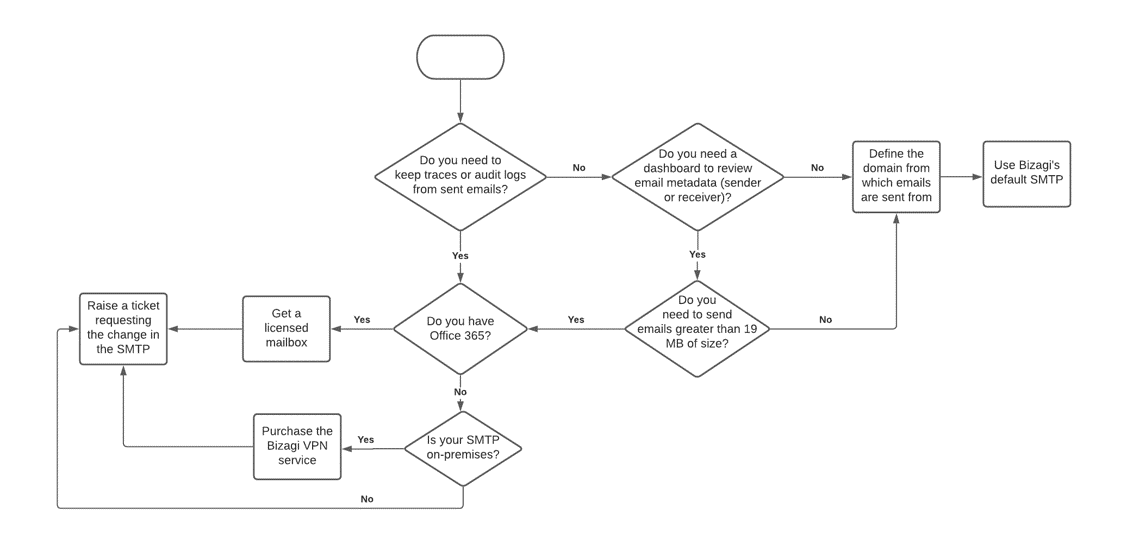Bizagi by default is not able to send emails. It needs to use an SMTP server that handles email sending to different email servers.
This SMTP sender server behaves as your local “electronic post office,” where all the notifications that must be sent are received and queued. Then each notification is sent to the correspondent destination “electronic post office” through your Internet Service Provider. Finally, the destination SMTP server sends each notification.

Before sending the body of the e-mail, the sender SMTP gets the location of the receiver looking at its IP address. To do that the SMTP sender searches in the Mail Exchanger record, which holds the association of a DNS, for example, mydomain.com, with its IP. Once the location is obtained, the sender SMTP server establishes a session with the SMTP receiver and validates that the e-mail address is valid. Finally, the SMTP sends the body of the message. This session is opened using commands from the SMTP standard.

For an email, the steps to open and send a notification are the following:
1.Open session.
2.Get the IP address of the SMTP receiver in the Mail Exchanger. The mail exchanger contains the DNS of servers and gives back the IP address.
3.Validate the sender.
4.Validate the receiver.
5.Send data.
6.Close session.
By default, Bizagi uses its own cloud-based SMTP so you don’t need to configure settings via UI but need to specify a domain and add CName records.
Refer to Email services. Therefore, no additional configuration is needed on your part.

Using your own SMTP server
You can use your own SMTP or Email Provider as the Sender. You can configure an SMTP in two ways:
•Using a Internet Service Email provider like Office365.
•Using your SMTP server. If this server is on-premises you must use a VPN.
This option will increase YOUR administration tasks with Bizagi. By providing your own SMTP or Email Provider, there are SHARED RESPONSIBILITIES. When your system is not responding, Bizagi's support team reviews the reasons. Usually Bizagi identifies your STMP is down, and you need to review the connection to guarantee it works as expected.
Most customers that choose their own STMP at the beginning of the contract, change to Bizagi's default sender over time.
For further information about the information required by Bizagi, refer to Using your own SMTP.
Because Bizagi needs to reach the Sender SMTP it is important that there are no restrictions such as IP whitelists or network firewalls.

Considerations for Office 365
•If you are using Office 365 you need a licensed mailbox, so you have the availability for outgoing emails.
•If using Office 365 you must use the DNS name. IP addresses are not supported.
•For Office365, TLS is enforced (using SMTPS).
Considerations for your own SMTP
•Customer sender SMTP must be able to use basic SMTP authentication. Therefore, you need at least one service account (username with password). Such service account cannot use MFA and ideally having a non-expiring password (to avoid admin overhead and potential service disruption). It is recommended to use a separate service account per environment (e.g. one for test another for production).
•The communication between Bizagi and your SMTP server is done enforcing the TLS protocol as long as your SMTP server has a certificate issued by a public CA entity (self-signed certificates or ones issued by a local CA are not supported because these cannot be installed in Bizagi).
•The email sender is your SMTP, not Bizagi, therefore, you must manage the SMTP availability and performance.
•Message signature using certificates is NOT supported.
The following image describes the communication flow between Bizagi and your SMTP.

1.When Bizagi needs to send an email notification, it creates the email request.
2.This email request is sent including the SMTP credentials. This communication between Bizagi and your SMTP is secured using the TLS protocol (SMTPS) if your SMTP strictly uses a certificate issued by a public CA entity
3.Your SMTP verifies the credentials.
4.If they are ok, then the SMTP establishes the session with the receiver as described previously, and sends the email to the recipient's inbox.
How to define the best SMTP option
The following diagram can help you to choose between using the Bizagi's SMTP or your own. Consider that if you choose not to use Bizagi's default SMTP, all the administration of the SMTP is on you, and Bizagi does not give support when email sending fails.

Last Updated 1/20/2023 9:38:37 AM